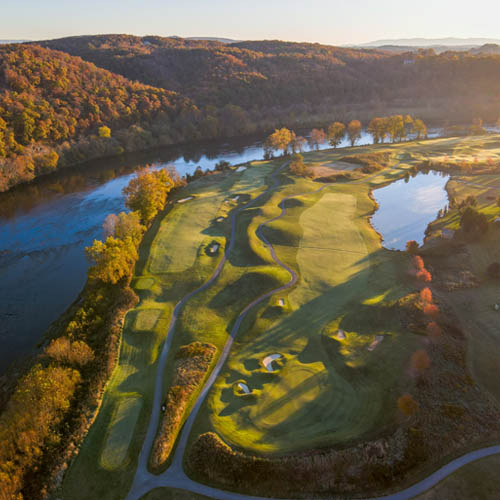
A deeper look into the rewarding challenges of the Pete Dye River Course of Virginia Tech
On twisting links-style greens in Radford, Virginia, everything leads to the river: your gaze, the next challenge, and the sloping fairways.
Pete Dye River Course of Virginia Tech sits on a uniquely scenic site, tucked onto a horseshoe-shaped peninsula that for 2.5 miles is fronted by the New River, one of the oldest rivers in the world — and one of only a handful that flow north. Perched on a ledge overlooking the front nine from one direction and the back nine from another, a 15,000-square-foot clubhouse offers sweeping views and delicious post-round bites in a relaxed upscale atmosphere.
“When was the last time during a round of golf you saw bald eagles, pileated woodpeckers, kingfishers, green herons, or Baltimore orioles? That can happen any day at the river,” insists member Bobby Swain. “Or even a flyover by the Navy or Air Force, all while enjoying the peaceful, tranquil surroundings,” adds Swain.
It was this naturally immersive — and challenging — layout that captivated Pete Dye. “A Virginia Tech alumnus named Bill Goodwin brought in Pete Dye to redesign the course in 2006.” When Pete Dye stepped onto the fairways, “he was just taken with the river,” says Pete Beller, a member and Radford local. “Of course, he put his signature into it with the bunkers and the layout of the course. It’s unique for golfers because this isn’t a basic course with no undulations or bunkers. It has professional design features built into it, and we’ve had to learn those features by playing them, which is fun for me,” laughs Beller.
Those same challenging features are why The River Course’s fiercely loyal members can’t seem to stay away — even in the winter months, when the practice facilities, indoor simulator and driving range are bustling. “The course has a very unique character: it has a links ‘flavor’ to it that you see in European golf courses, but isn’t a links course as you would know one to be,” says Beller. “You need to really place your shots and control your misses. That’s one of the hallmarks of the course, in that it makes you think when you play — the way a real championship golf course should.”
Bentgrass turf keeps the course firm and fast in the summertime, where “golfers can get a tighter lie, with lots of opportunities to run the Flat Stick around the greens,” adds Swain.
“And the Pete Dye design features four par 3s that all go in different directions. There is basically a 90-degree bend in the river between holes 9 and 10.”
The result? Golfers truly have to plot the course ahead of time. “Golf is the hardest game ever, in my opinion, and Pete Dye courses are more difficult than most,” says Quinton Nottingham, member. “When you’re approaching any hole on The River Course, you have to carry the ball all the way onto the grid — otherwise, you’d better have a really good short game, because they’re not going to roll up on the greens. Plus, there are very few trees on the course, so you need to keep the ball in play. It really does make you think through every hole, rather than just gripping and ripping. You need to play the hole in your head before you can really attack it. It certainly forces you to become a better golfer.”
If you’re up for the challenge, the Pete Dye River Course offers something rare and remarkable: an immersive round surrounded by unique natural elements not found anywhere else in the world — and plenty to discuss over a post-game round of drinks in the clubhouse.